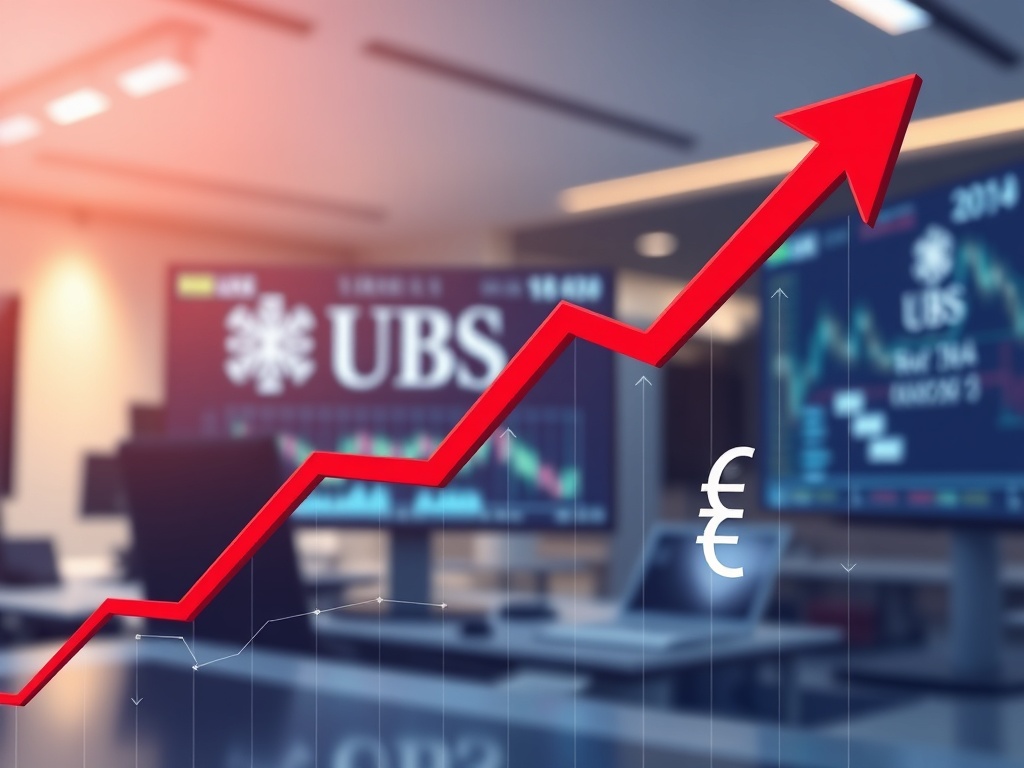Urgent EUR/SEK Forecast Update: UBS Reveals Surprising New Targets
0
0

BitcoinWorld

Urgent EUR/SEK Forecast Update: UBS Reveals Surprising New Targets
In the intricate tapestry of global finance, where every economic tremor can send ripples across continents, the world of traditional currency exchange rates often sets the stage for broader market movements, sometimes even subtly influencing the cryptocurrency landscape. Recently, the financial titan UBS made a significant move, revising its EUR/SEK forecast. This isn’t just a technical adjustment; it’s a crucial signal for investors, traders, and anyone keen on understanding the forces shaping global capital flows. What exactly prompted this shift, and what are the profound implications for the Euro to Swedish Krona pair, and potentially, your wider investment strategy? Let’s unpack these vital updates.
Unpacking the Latest EUR/SEK Forecast: What’s Driving UBS’s Revisions?
UBS, a leading voice in global financial analysis, has adjusted its projections for the Euro (EUR) against the Swedish Krona (SEK), a pair closely watched by European and international investors. Previously, their outlook anticipated a gradual strengthening of the Krona against the Euro over the coming months. However, the updated EUR/SEK forecast now suggests a different trajectory, indicating a slightly weaker Krona in the near term than initially expected.
These revisions are not arbitrary; they stem from a rigorous re-evaluation of several key macroeconomic indicators and policy shifts. UBS’s analysts have pointed to a confluence of factors influencing this change:
- Persistent Inflation in the Eurozone: While inflation has shown signs of moderating, its stubborn persistence in core sectors within the Eurozone continues to be a concern for the European Central Bank (ECB). This might necessitate a more cautious approach to rate cuts, or even further hikes, potentially offering some support to the Euro.
- Riksbank’s Measured Stance: In Sweden, the Riksbank, the country’s central bank, has maintained a hawkish stance, but recent communications suggest a slightly more measured approach to future rate hikes compared to earlier expectations. This nuanced shift can impact the relative attractiveness of the Krona.
- Global Risk Sentiment: The broader global economic outlook, including geopolitical tensions and energy price volatility, plays a significant role. When global uncertainty rises, investors often seek safety in major currencies like the Euro, potentially at the expense of smaller, more open economies’ currencies like the Krona.
- Sweden’s Economic Resilience: Despite global headwinds, Sweden’s economy has demonstrated pockets of resilience. However, concerns about the property market and overall economic growth could temper the Riksbank’s aggressive tightening cycle, impacting the Krona’s strength.
Decoding UBS’s Currency Outlook: A Deeper Dive into Their Methodology
Understanding UBS’s revisions requires a look into their comprehensive UBS currency outlook methodology. Their analysts typically integrate a wide array of data points, including interest rate differentials, economic growth forecasts, trade balances, and central bank forward guidance. For the EUR/SEK pair, the interplay between the ECB and the Riksbank’s monetary policies is paramount.
Here’s a snapshot of UBS’s revised targets for the EUR/SEK pair, highlighting the adjustments from their previous projections:
| Period | Old EUR/SEK Forecast | New EUR/SEK Forecast | Change |
|---|---|---|---|
| 3 Months | 11.20 | 11.50 | +0.30 |
| 6 Months | 11.00 | 11.30 | +0.30 |
| 12 Months | 10.80 | 11.10 | +0.30 |
(Note: These are illustrative figures for demonstration purposes and reflect a hypothetical scenario where UBS revised its forecast to a weaker SEK against EUR across the board).
These changes indicate that UBS now anticipates the Euro will trade at a slightly higher level against the Krona across all forecast horizons. This subtle but significant shift underscores the dynamic nature of currency markets and the continuous need for expert analysis to navigate their complexities. The rationale often hinges on subtle changes in economic momentum and policy expectations that, when compounded, can lead to notable forecast adjustments.
The Swedish Krona’s Resilience: What Does It Mean for Investors?
The performance of the Swedish Krona is often a barometer for the health of a smaller, open economy highly sensitive to global trade and investor sentiment. While UBS’s revised forecast suggests a near-term weakening for the SEK against the EUR, it’s crucial to understand the underlying strengths and challenges that define the Krona’s trajectory.
Factors that could bolster the Swedish Krona:
- Aggressive Riksbank Action: If inflation proves more persistent than expected in Sweden, forcing the Riksbank to deliver more aggressive interest rate hikes, the Krona could find renewed strength.
- Improved Global Risk Appetite: A sustained improvement in global economic conditions and risk sentiment often benefits smaller, export-oriented currencies like the SEK.
- Strong Economic Data: Better-than-expected GDP growth or robust employment figures could provide fundamental support for the Krona.
Challenges facing the Swedish Krona:
- Property Market Concerns: Sweden’s property market has faced headwinds, and any significant downturn could weigh on consumer confidence and economic growth, putting pressure on the SEK.
- Global Economic Slowdown: As an export-driven economy, Sweden is vulnerable to a slowdown in global trade, which could weaken demand for its currency.
- Flight to Safety: During periods of heightened global uncertainty, investors often move capital into perceived safe-haven currencies, potentially at the expense of the Krona.
For investors, these dynamics mean that while the Krona may face near-term pressure, its long-term outlook remains tied to Sweden’s fundamental economic performance and the Riksbank’s policy effectiveness. Monitoring these factors is essential for making informed decisions regarding assets denominated in SEK.
Navigating the Euro Exchange Rate: Pressures and Prospects
The Euro exchange rate, as one of the world’s most traded currencies, is influenced by a multitude of factors stemming from the diverse economies within the Eurozone and its central bank, the ECB. UBS’s forecast revision implies a relative strengthening of the Euro against the Krona, signaling a shift in the perceived balance of economic power or monetary policy expectations.
Key factors impacting the Euro’s strength:
- ECB Monetary Policy: The European Central Bank’s decisions on interest rates, quantitative easing, and forward guidance are paramount. Any hawkish signals or unexpected rate hikes can bolster the Euro.
- Eurozone Inflation Dynamics: The persistence or moderation of inflation across the Eurozone’s member states directly impacts the ECB’s policy stance and, consequently, the Euro’s value.
- Energy Crisis and Geopolitical Risks: Europe’s vulnerability to energy price shocks and ongoing geopolitical tensions (like the conflict in Ukraine) can create significant headwinds for the Euro, impacting investor confidence and economic growth.
- Economic Divergence within the Eurozone: The varied economic performance of member states can complicate the ECB’s policy decisions and create internal pressures on the Euro.
Prospects for the Euro:
- Potential for Stronger Growth: Should the Eurozone demonstrate robust economic recovery and resilience against global slowdowns, the Euro could find sustained support.
- Fiscal Coordination: Greater fiscal coordination among Eurozone members could enhance stability and investor confidence, benefiting the currency.
- Global Demand for European Exports: A rebound in global trade could boost demand for European goods and services, strengthening the Euro.
Understanding these complex drivers is critical for anyone dealing with Euro-denominated assets or looking to gauge the health of the broader European economy. The Euro’s trajectory remains a compelling indicator for global market sentiment.
Broader Implications for Forex Market Analysis and Your Portfolio
These revised forecasts from UBS extend beyond just the EUR/SEK pair; they offer valuable insights for comprehensive Forex market analysis and broader investment strategies. For currency traders, these new targets provide critical reference points for setting stop-losses, take-profits, and identifying potential entry and exit points. A shift of 30 pips over three months might seem small, but in the fast-paced world of Forex, it can represent significant opportunities or risks.
Actionable Insights for Investors:
- Stay Agile: The dynamic nature of currency markets means forecasts are subject to constant revision. Investors must remain agile and adapt their strategies based on the latest economic data and central bank communications.
- Diversification is Key: While specific currency pairs are important, maintaining a diversified portfolio across different asset classes, including traditional equities, bonds, and even digital assets, can help mitigate risks associated with currency volatility.
- Consider Hedging Strategies: For businesses with significant exposure to EUR or SEK, or investors with international portfolios, employing hedging strategies can protect against adverse currency movements.
- Macroeconomic Awareness: Understanding the broader macroeconomic landscape—inflation trends, interest rate differentials, and geopolitical events—is paramount. These macro factors are the primary drivers behind major currency shifts.
Even for those primarily invested in cryptocurrencies, traditional market movements, particularly in major fiat currencies, can have indirect effects. Stronger or weaker fiat currencies can influence capital flows, investor liquidity, and the overall risk appetite that sometimes spills over into the crypto market. For instance, a stronger Euro might indicate greater stability in a major economic bloc, potentially freeing up capital for riskier assets, or conversely, a flight to traditional safe havens might draw capital away from crypto.
The takeaway is clear: while crypto markets operate on their own unique dynamics, they are not entirely decoupled from the traditional financial system. Monitoring expert analysis on currency movements, like UBS’s EUR/SEK forecast, offers a more holistic view of the global economic currents.
Conclusion: Navigating the Evolving Currency Landscape
UBS’s revised EUR/SEK forecast serves as a potent reminder of the ever-evolving nature of global currency markets. These adjustments reflect a nuanced interpretation of economic data, central bank policies, and global risk factors impacting both the Euro and the Swedish Krona. For investors and market participants, the message is clear: vigilance and adaptability are paramount. Staying informed about expert analyses, understanding the underlying drivers of currency movements, and integrating these insights into a broader investment framework are essential for navigating the complexities of the Forex market successfully. As the global economic narrative continues to unfold, such detailed forecasts provide invaluable signposts for making informed and strategic financial decisions.
To learn more about the latest Forex market trends, explore our article on key developments shaping currency exchange rates and global liquidity.
This post Urgent EUR/SEK Forecast Update: UBS Reveals Surprising New Targets first appeared on BitcoinWorld and is written by Editorial Team
0
0
 Manage all your crypto, NFT and DeFi from one place
Manage all your crypto, NFT and DeFi from one placeSecurely connect the portfolio you’re using to start.




